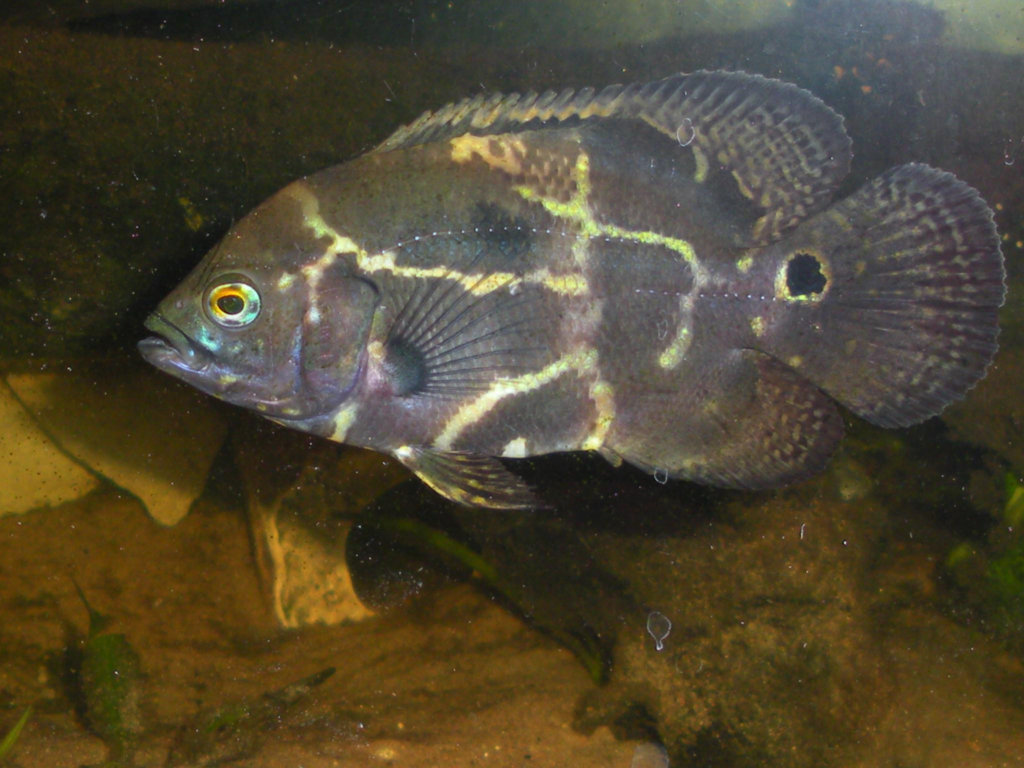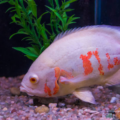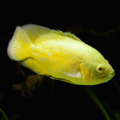In the alluring world of freshwater fish, the Wild Oscar fish stands out as a marvel of beauty, splendor and resilience. Hailing from the slow-moving rivers of South America, these natural cichlid species captivate aquarium enthusiasts and scientists alike with their striking appearance and dynamic personality.

Introduction to Wild Oscar Fish
The wild Oscar is the original parent fish of the Oscar variety; other variants in the hobby were derived from this fish. This Oscar is known for its astonishing coloration and patterns. Its body is designed with hues ranging from deep black and bright oranges to reds and gold.
Its vivid coloration, coupled with eye-like spots around its body, enhances its visual appeal, making it an aquarium hobbyist’s favorite. These bright patterns not only add to the Oscar fish’s allure but also confuse predators and rivals, making them a more elusive target.
In its native habitat, this wild aquarium fish thrives in various water conditions, from slow-moving rivers to swampy floodplains. Its adaptability can be seen in its resilience, allowing it to survive in diverse and harsh environments.
If you are interested in this wild but enchanting species of Oscar, this care guide is just what you need. I have provided you with everything you need to know about maintaining the health and allure of the beautiful wild cichlid.
History and Natural Habitat
The Wild Oscar’s origin can be traced to the diverse and sprawling South American rivers. Its natural habitat ranges from the complex waterways of the Amazon Basin as well as the Rio Orinoco Basin in Colombia and Venezuela.
Their natural habitat’s conditions are specific, playing an important role in their growth, metabolic process and overall health. It thrives in warm freshwater ecosystems which are slightly acidic to neutral and have abundant vegetation.
This cichlid’s adaptations contribute to its ability to navigate through dense vegetation and muddy substrates, allowing it to hunt effectively and escape predators.
Physical Characteristics

The wild Oscar fish has physical characteristics that set it apart from other freshwater fish and its domesticated counterparts. Let’s talk about the wild Oscar’s appearance and its unique features.
Size and Shape
Wild Oscars have a pretty impressive size when in their natural habitat. They grow to an average length of about 12 to 18 inches (30 to 45cm); some can reach up to 20 inches or more.
Domesticated Oscars can also grow to a similar size, but the size of their tanks and diet play a role in their development. Some may not reach the maximum sizes as seen in the wild Oscar. They have a robust body that appears laterally compressed, helping them navigate through dense vegetation.
Coloration and Patterns
Oscar’s natural fish coloration and patterns are one of the most attractive features of this species. In the wild, you can find them exhibiting a wide range of colors, ranging from deep black colors, earthy brown and even vibrant orange and red coloration.
Their bodies are decorated with distinctive patterns, which include eye-like spots called ocelli, spots and stripes which could serve as camouflage in their natural habitat.
Distinctive features
Oscar fish traits and distinguishing wild features are heavily influenced by their natural habitat. They are equipped with a broad mouth and powerful jaws that help them catch and consume a diverse range of prey.
Their large and expressive eyes are adapted to enhance their vision in dark environments. They also possess elongated and pointed fins, helping them move in a precise manner through dense underwater vegetation.
Generally, the cichlid’s size variation depends on its environment. In the wild, the complex environments of the Amazon basin help them grow into larger sizes, which is an adaptation that allows them to hunt various prey. Domesticated Oscars’ sizes, on the other hand, may be limited by their diet and tank size; meaning they’re usually smaller compared to the wild Oscars.
Ideal Tank Setup for Wild Oscar Fish

A key part of owning a wild Oscar is creating an environment that mimics their natural environment. The process of making the ideal tank environment for them can be both challenging and rewarding. Here are some guidelines to help you create a proper wild Oscar tank setup.
Tank Size
If your wild Oscar is young, you will require a minimum aquarium size of 75 gallons (284 liters). However, adult Oscars require significantly larger tanks due to their length and robust body.
A larger tank, such as one of at least 125 gallons, provides them with more space to move around, reducing stress and promoting their well-being. I would always advise to go for larger tanks, about 150 to 200 gallons. This is even better if you plan to grow a community tank with other species.
Natural Aquarium Design
When designing the tank, you should opt for designs closer to their natural environment. Your focus should be on horizontal rather than vertical space, which gives them plenty of room to swim around comfortably.
You could include smooth gravel or sand to replicate the soft environment they are accustomed to. You should also incorporate large rocks and driftwood to mimic the submerged logs and rocks in their natural habitat.
Water Parameters
An important factor in creating an optimal tank environment for your pet is sticking to strict water parameter guidelines. Your tank temperature should be kept between 74°F and 81°F (23°C to 27°C). You can maintain this temperature by installing a reliable thermostat. Your pH range should be 6.5 to 7.5; a water hardness of 3 to 15 dGH is preferred.
Incorporating these guidelines when building a home for your pet is the best way to create an authentic aquatic habitat suited to its distinct features.
Feeding and Diet

Like their domesticated counterparts, wild Oscars are omnivorous and enjoy a wide variety of food choices. They particularly enjoy live foods and love to chase them. The wild Oscar’s diet requires vitamin C to help it remain vibrant and healthy.
Their primary diet is a mix of high-quality protein obtained from invertebrates like crickets, beetles, worms and crustaceans. They also feed on smaller fish species and their fry.
Occasionally, they may consume plant material or algae, particularly those similar to the vegetation in their natural habitat. It’s best to stick to their natural feeding habits and food source as this contributes to their agility.
For more on feeding your aquatic pets check out The Ultimate Guide to Fish Food: Pros and Cons & Best Choices!

The wild cichlid’s nutrition could also contain commercial fish food like high-quality pellets and flakes. Choose pellets that are best suited for large cichlids or carnivorous fish. This is to ensure you meet their needs and dietary balance in captivity.
There’s a variety of Oscar fish food choices to choose from as a fish owner; this makes it easy to feed your pet and provide the best quality of food for them. Sticking to a strict feeding schedule is important to avoid overfeeding your fish.
Health and Common Diseases
Wild Oscar fish are known to be pretty resilient and hardy, but they often fall susceptible to common health issues. Here are some diseases that could affect your Wild Oscar’s health:
Ich
This is one of the most common fish illnesses. They appear as white, salt-like cysts in their bodies, gills and fins. This may cause them to rub against objects. You can treat this illness by gradually raising the temperature of the water to accelerate the parasite’s life cycle.
For more details checkout our article on How to Treat Ich Outbreaks in Your Freshwater Fish!
Fin Rot
This is another common illness, and it can be noticed as frayed or discolored fins. It can easily be prevented by maintaining clean water conditions. If you notice these features, administer antibiotics or antifungal medications.
Cotton Mouth Disease (Columnaris Disease)
These are cotton-like growths on mouths, gills or fins. You could also find red or inflamed areas around the fish’s body. This is detectable by monitoring your fish for cottony lesions and signs of respiratory distress. You could also treat this with the use of antibiotics or antifungals.
Fish disease prevention can be easily achieved by regular tank cleaning and aquatic health care checks. Your Oscar fish’s wellness and health are a priority, and you must adopt feasible disease management strategies to ensure they are healthy, happy and strong.
Breeding Wild Oscar Fish
Breeding wild Oscars can be rewarding if the right breeding conditions are met. This cichlid’s mating behavior is intriguing as they tend to be selective with their breeding pairs.
Oscars are also known to create strong bonds when they select a mate. When they are ready to breed, they exhibit elaborate courtship displays and may tend to synchronize swimming and increase territorial behavior.
For a successful Oscar fish reproduction, you should maintain stable water quality and keep temperatures between 6-82°F (24-28°C). Regular water changes should also be done. The fry typically takes about 72 hours to hatch when they lay their eggs.
This video has been very helpful in identifying the sex of Oscar fish, I highly recommend it:
At this stage, it is important to separate the parents and focus on caring for your fry. An important fish-rearing tip to consider is to feed your fry diligently with finely crushed meals for as long as you can to stimulate their growth.
Also, maintain optimum water conditions and stable water parameters. Regular water changes could reduce the risk of disease or death.
If you hope for a successful fish breeding experience, you must pay attention to detail and be patient when caring for and monitoring your Oscar fry.
Behavior and Compatibility
Wild Oscars are known for their intelligence and remarkable personality. Understanding the wild Oscar’s behavior is key to managing their aquarium interactions with other cichlids or fish species. This is particularly important when building a community tank.
Cichlid’s social dynamic is peculiar; they are capable of problem-solving and even learn to respond to stimuli or perform tricks. They also have a very good memory and tend to recognize their keepers.
They tend to be pretty territorial, which affects their compatibility. Here are some wild Oscar fish compatibility tips:
· Choose appropriate tank mates: You should opt for robust fish like large catfish or other large cichlids.
· Avoid incompatible fish: Avoid small fish, as these serve as prey for the Oscars. Opt for large-sized fish and other aggressive cichlids.
· Provide ample space and hiding spots: Ensure your tank is large enough to accommodate all your fish and has ample space for swimming. Also, provide hiding spots in the form of rocks, driftwood and plants. This helps reduce territorial aggression and provides non-aggressive fish a place to retreat.
Managing aquarium interactions is quite easy if you follow these tips. You can also control your Oscar fish’s temperament by gradually introducing new aquarium fish into the tank to minimize stress. Closely monitoring interactions is also important, especially after introducing new fish.
Conclusion
Caring for a wild Oscar can be overwhelming, but if you stick with it, it can be a very rewarding experience. Thanks to their dynamic personalities and intelligence, this fish offers more than just their beauty and charm.
With this wild Oscar care overview, caring for your pet would be less challenging than you may have imagined. A reliable aquarium enthusiast advises new hobbyists to ensure your fish is giving everything it needs to maintain its beauty and good health. If properly cared for, these unique aquarium species can remain beautiful for as long as they live.
Your Oscar fish’s appreciation goes beyond feeding them; you must also engage and interact with them to keep them happy and sharpen their intelligence. Whether new to the hobby or an old timer, you’d have nothing to regret if you bring home a beautiful wild Oscar.










